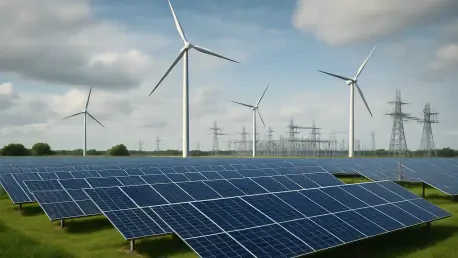The global push toward green energy is unleashing profound changes across industries, economies, and geopolitical landscapes, creating a ripple effect that is impossible to ignore. As nations and corporations race to address climate change, the transition from fossil fuel dependency to renewable energy systems is redefining the very foundation of resource valuation and trade. This monumental shift is not merely about adopting cleaner technologies; it is a complete overhaul of commodity markets, where materials essential for sustainable energy are becoming the new currency of power. The surge in demand for critical minerals like lithium, copper, and nickel—vital for electric vehicles, solar panels, and wind turbines—has introduced unprecedented volatility, as supply struggles to match the pace of ambition. With climate goals driving policy and innovation, this transformation presents both immense opportunities and significant challenges. This article delves into the intricate dynamics of this green revolution, exploring how it reshapes market trends, fuels investment surges, and alters global power structures. Drawing on the latest data and insights, the discussion aims to unpack the forces behind the volatility and the broader implications for stakeholders navigating this evolving landscape.
Rising Demand for Essential Minerals
The transition to green energy is fundamentally transforming commodity markets by placing critical minerals at the center of the energy paradigm. Materials such as lithium, copper, and rare earth elements, once niche resources, are now indispensable for powering electric vehicles, battery storage systems, and renewable energy infrastructure. Projections indicate that demand for these minerals could triple by 2030 as global renewable energy targets intensify, driven by the urgent need to decarbonize. This escalating appetite is reshaping market dynamics, positioning these resources as the backbone of a sustainable future. However, the rapid increase in demand is outpacing the ability of supply chains to respond, creating a precarious imbalance that threatens to disrupt the very industries it aims to support. The stakes are high, as these minerals are not just commodities but the building blocks of a cleaner world, making their availability a pressing concern for policymakers and industry leaders alike.
Supply constraints are a significant driver of the volatility seen in these markets, as the process of bringing new mining projects online is notoriously slow and complex. Many projects take over a decade to develop due to regulatory hurdles, environmental concerns, and the sheer scale of investment required. Moreover, production is often concentrated in a handful of regions, with countries like China dominating the supply of rare earths and other key materials. This geographic concentration exacerbates risks of bottlenecks and supply disruptions, especially when geopolitical tensions or trade disputes come into play. The resulting price swings—sometimes referred to as “greenflation”—impact everything from the cost of electric vehicle batteries to the feasibility of large-scale renewable projects. As industries compete for limited resources, the pressure on prices creates a challenging environment for manufacturers and investors, who must navigate uncertainty while planning for long-term growth.
Investment Surge in Renewable Sectors
The green energy shift is triggering an extraordinary wave of investment into clean energy technologies and related industries, reshaping the financial landscape at a remarkable pace. Government initiatives, such as the U.S. Inflation Reduction Act, have injected hundreds of billions of dollars into green projects, incentivizing the development of solar, wind, and battery technologies. These public funds are complemented by a flood of private capital, as investors recognize the potential for significant returns in sectors aligned with sustainability goals. Companies specializing in renewable energy production and critical mineral extraction are emerging as market leaders, capitalizing on the growing demand for their products and services. This investment boom signals a profound shift in capital allocation, favoring green innovation over traditional energy models and creating a clear divide between sectors poised for growth and those facing obsolescence.
While renewable energy firms and mineral miners are reaping the benefits of this capital influx, traditional fossil fuel companies are grappling with declining demand and increasing regulatory scrutiny. The transition poses existential challenges for these legacy players, many of whom struggle to pivot to renewable portfolios due to high transition costs and entrenched business models. In contrast, agile companies at the forefront of clean energy are seeing stock valuations soar, driven by market confidence in their alignment with global trends. For instance, firms involved in battery manufacturing and renewable infrastructure are benefiting from heightened demand in tech-driven sectors like artificial intelligence, which require substantial energy solutions. This disparity underscores the uneven impact of the green shift, where investment is not just a financial decision but a strategic bet on the future of energy, with winners and losers becoming increasingly apparent.
Geopolitical Realignments and Resource Control
The move toward green energy is not just an economic or technological shift; it is a profound geopolitical realignment that is reshaping global power dynamics in unexpected ways. The dominance of “petrostates”—nations whose influence stemmed from vast oil reserves—is waning, giving rise to “electro-states” that wield power through control of critical minerals and renewable energy technologies. Countries with significant reserves of lithium, copper, and other essential materials are gaining strategic importance, positioning themselves as key players in the new energy order. This transition introduces fresh dependencies, as nations reliant on imported resources must forge new alliances to secure their energy futures. The geopolitical stakes are high, with resource control becoming a central axis of international relations and economic strategy.
This shift also brings new risks to commodity markets, as geopolitical tensions over mineral supply chains can amplify volatility and disrupt global trade. Nations dominating production, such as China with its grip on rare earth elements, hold considerable leverage, creating potential flashpoints in regions dependent on these imports. Energy security, once defined by access to oil and gas, now hinges on reliable supplies of critical materials, prompting governments to rethink their diplomatic and trade policies. The uncertainty surrounding resource access can lead to sudden price spikes or supply shortages, further destabilizing markets already strained by demand pressures. To mitigate these risks, international cooperation and diversified supply chains are essential, requiring a delicate balance of competition and collaboration to ensure stability in this rapidly evolving landscape.
Policy Frameworks Accelerating Change
Government policies are playing a pivotal role in driving the green energy transition, setting the stage for rapid transformation across industries and markets with ambitious targets. Programs like the U.S. Inflation Reduction Act and the European Union’s REPowerEU plan are not just funding mechanisms; they are bold statements of intent to prioritize renewable adoption over fossil fuel reliance. These initiatives stand in stark contrast to historical energy transitions, which were often gradual and market-led, as today’s policies are fueled by the urgency of climate change mitigation. By establishing clear goals—such as significant increases in renewable energy consumption by 2030—these frameworks are pushing industries to innovate and adapt at an unprecedented pace. However, the speed and scale of these mandates also introduce uncertainties that ripple through commodity markets, challenging stakeholders to keep up.
The policy-driven push for sustainability is forcing industries to rethink traditional practices, often under tight timelines that add pressure to already volatile markets. Oil and gas companies, for instance, are exploring renewable ventures, while manufacturers invest in technologies like green hydrogen and smart grids to align with regulatory expectations. Yet, this rapid adaptation is not without hurdles, as ethical concerns over mining practices and the environmental impact of resource extraction remain unresolved. Additionally, sudden policy shifts or changes in funding priorities can alter market forecasts overnight, contributing to price instability for critical minerals. A balance between urgency and predictability in policy design is crucial to provide industries with the confidence to invest long-term, ensuring that the green transition does not falter amidst short-term disruptions or misaligned incentives.
Navigating Opportunities and Obstacles
The green energy shift embodies a dual narrative of immense potential and formidable challenges, presenting a complex landscape for stakeholders to navigate. On one hand, emerging markets endowed with abundant critical minerals stand to gain economically from the global demand surge, positioning themselves as vital contributors to the renewable revolution. Technological advancements are also lowering the costs of solar and wind energy, making renewables increasingly competitive and accessible across diverse regions. This creates a promising outlook for widespread adoption, particularly in areas previously reliant on fossil fuels. The opportunities are vast, offering pathways for innovation, economic growth, and environmental benefits that could redefine global energy systems for generations to come, provided the momentum is sustained through strategic investments.
On the other hand, significant obstacles threaten to derail progress if left unaddressed, casting a shadow over the green energy horizon. Supply chain vulnerabilities remain a critical concern, as delays in mineral production and geographic concentration of resources heighten the risk of shortages. Financing gaps, especially in developing nations, hinder the ability to scale up renewable infrastructure, while the environmental and social impacts of mining raise ethical questions that demand attention. There is also the risk of perpetuating commodity dependence in resource-rich regions, rather than fostering value-added industries like manufacturing or processing. Addressing these challenges requires a coordinated effort among governments, industries, and investors to prioritize resilience, equity, and sustainability, ensuring that the transition does not exacerbate existing disparities or create new ones.
Future Pathways for Stability and Growth
Reflecting on the green energy shift, it is evident that the journey embarked upon in recent times has fundamentally altered commodity markets and investment priorities. The surge in demand for critical minerals, coupled with policy-driven investments, has set a transformative course, while geopolitical realignments underscored the strategic importance of resource control. Volatility in markets was a defining feature of this period, as supply constraints and rapid policy changes tested the resilience of industries worldwide. The dual nature of challenges and opportunities shaped the narrative, revealing both the promise of a sustainable future and the complexities of achieving it. Looking back, the efforts to balance innovation with stability laid critical groundwork for what was to come, highlighting the necessity of collaboration across borders and sectors.
Moving forward, the focus must shift to actionable strategies that mitigate volatility and ensure long-term success in the green energy landscape. Governments should prioritize stable, transparent policies that support emerging markets through accessible financing, enabling them to participate fully in the renewable boom. Industries need to invest in supply chain diversification and recycling initiatives to reduce dependence on concentrated mineral sources, while embracing technological solutions to enhance efficiency. For investors, a keen eye on sustainability metrics and geopolitical developments will be essential to navigate risks and seize growth opportunities. Ultimately, fostering international partnerships to secure critical resources and share innovation can pave the way for a more resilient energy future, turning the challenges of the past into stepping stones for enduring progress.









